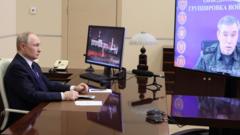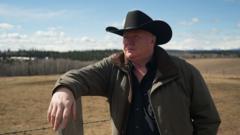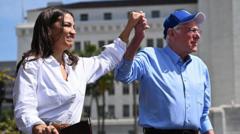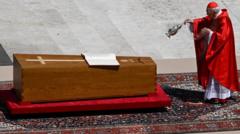With just days left before the election, Canadian leaders Mark Carney and Pierre Poilievre are rallying their supporters around a backdrop of vibrant nationalism and frustration over U.S. policies, drastically reshaping the anticipated outcome. The shifting dynamics are leading to a potential resurgence for the Liberals, under Carney’s leadership, as polls indicate a tight race against the Conservatives.
Canada's Political Landscape Shifts Dramatically Ahead of Pivotal Election
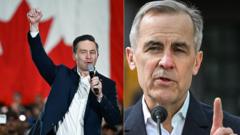
Canada's Political Landscape Shifts Dramatically Ahead of Pivotal Election
Tensions mount as Canada's political parties address the significant influence of U.S. relations in the lead-up to the critical federal election, showcasing a heated contest between the Conservatives and Liberals.
As the countdown to Canada's federal election reaches its final hours, a thrilling contest is unfolding between the Liberal leader Mark Carney and Conservative leader Pierre Poilievre. At a recent political rally in London, Ontario, Carney warned his supporters about the "existential threat" posed by President Trump, as crowds rallied with Canadian flags attached to ice hockey sticks, demonstrating rising enthusiasm in the face of U.S. economic pressures.
Poilievre has also drawn substantial crowds, reigniting a sense of Canadian pride with his rallying cry, “Bring it Home,” which calls for votes in favor of government change amidst U.S. tariff threats. While the latest national polls indicate the Liberals maintain a slender edge, the shadow of Donald Trump looms large. Political analysts predict the party best equipped to address Trump's influence could sway undecided voters.
The political landscape has transformed dramatically since early 2025, when the Conservatives initially dominated national polls by as much as 20 points. However, a series of unexpected events, including Justin Trudeau's resignation and Carney's unexpected rise, have now shifted momentum. With Trudeau's growing unpopularity, many Liberals seem ready to regroup under Carney's guidance, creating a surge of support driven by discontent with the last decade of governance.
Voter frustrations, particularly regarding housing and economic prospects for younger generations, have amplified Poilievre's appeal. Yet, despite garnering a loyal base, he faces criticism for adopting a figure resembling Trump, embracing combative tactics, and denouncing "woke ideology." Conversely, Carney’s calm demeanor and economic experience as a former central banker position him as a stabilizing candidate amidst volatility.
With divisions along party lines more apparent than ever, recent communications from the New Democratic Party (NDP) have emphasized strategic voting, urging supporters to either align with the Liberals for a supermajority or bolster the NDP’s representation in Parliament. In an election where historical party loyalties are being tested, both the Liberals and Conservatives are eyeing over 38% support, a feat unseen since 1975.
Ultimately, with substantial issues plaguing debates — from economic resiliency to regional divides over climate and Indigenous reconciliation — the election results promise to usher in a transformative chapter in Canadian politics. As the rhetoric intensifies with slogans of "experience, not experiments," the populace braces for a decision that could redefine the country's identity and future trajectory.



